Abstract
The Luxi Terrane (eastern China) exposes widespread Early Cretaceous alkaline rocks, whereas their petrogenesis remains controversial, including fractional crystallization, partial melting and crustal contamination regime. Here, we present petrology, geochemistry, sphene U-Pb geochronology and trace element data from the syenogranite, quartz syenite and quartz monzonite of the Guandimiao alkaline complex rocks to investigate their petrogenesis. Geochemical data suggest that these alkaline rocks show alkalic and peralkaline characters, and high Ga/Al ratios, SiO2, light rare-earth element (LREE), Zr and Nb, and low MgO, CaO, Eu contents, corresponding to A-type granites. Sphene trace elements in syenogranite and quartz monzonite show obvious fractionation between LREE and heavy rare-earth element (HREE) and high Th/U ratios, indicating a magmatic origin. They yield U-Pb lower intercept ages of 128 ± 2.3 Ma and 127 ± 1.3 Ma, representing the crystallization ages of these alkaline rocks. The negative correlations between CaO, Fe2O3 (Total), MgO, P2O5, TiO2, MnO and the pronounced depletion in Nb, Ta and Ti suggest that the alkaline rocks were formed by fractional crystallization. Additionally, the positive correlation between La/Hf and La, Th and Th/V, Ce/Yb and K2O, and Tb/Yb and Yb suggest that the alkaline melts are generated by partial melting. Such high Rb/Nb, (Th/Nb)N and Nb/Th ratios indicate crustal contamination during the magma emplacement. We, therefore, propose the magma source of the alkaline rocks in the Guandimiao complex originated by partial melting of lithospheric mantle, which experienced fractional crystallization and crustal contamination processes during its emplacement. Such complex alkaline rocks were probably formed in an extensional back-arc setting induced by the retreat of the subducting Izanagi plate.
1. Introduction
The Yanshanian orogenesis, correlated with the subduction of the Izanagi plate, resulted in widespread magmatism and ore formation in the Luxi Terrane [1,2,3], and formed a series of alkaline intrusive rocks and rare-earth element (REE) deposits in eastern China. Such REE deposits comprise the Weishan, Longbaoshan and Guandimiao REE deposits, which are spatially hosted by NW- and NWW-oriented faults [1,2,3,4,5]. Previous studies on the Early Cretaceous alkaline rocks in the Luxi Terrane indicate that the petrogenesis of the alkaline rocks remains controversial [6,7,8,9]. Previous studies proposed that decreases in TiO2, Al2O3, Fe2O3 (Total), MnO, MgO, CaO and P2O5 with an increasing SiO2 of the Weishan and Longbaoshan alkaline complex were caused by fractional crystallization [5,6,8]. The presence of inherited zircon grains (2639–2494 Ma) in the Weishan and Longbaoshan complex is evidence of crustal contamination [5,6,8]. Moreover, as the SiO2 contents increase, the Longbaoshan alkaline complex shows lower (87Sr/86Sr)i ratios and higher εNd(t) values, suggesting that the alkaline complex might have assimilated some crustal materials [8]. Liu et al. [7] interprets the positive correlation between La/Sm ratios and La abundance of the pyroxene syenite as partial melting, and the La/Sm ratios remain unchanged, with the increasing La content of the hornblendite as fractional crystallization for the Guandimiao complex. The presence of inherited zircon grains (2553–2178 Ma) from the pyroxene syenite of the Guandimiao complex suggests crustal contamination during magma emplacement [7]. The Guandimiao complex is composed of pyroxenites, hornblendites, dioritic porphyries, pyroxene syenites, quartz syenites, syenogranites and quartz monzonites, representing a fractionation sequence [7,10]. Previous studies have investigated the petrogenesis of the hornblendites and pyroxene syenites and proposed a fractional crystallization and partial melting model, with crust material contamination [7]. The petrogenesis of the alkaline sequence, including quartz syenites, syenogranites and quartz monzonites, however, remains ambiguous.
In the present study, we report the whole-rock geochemistry, sphene U-Pb geochronology and sphene trace-element geochemistry of the alkaline rocks in the Guandimiao complex. We aim to investigate the emplacement timing and origin of the alkaline sequence and shed light on the petrogenesis of the alkaline rocks in the Luxi Terrane, eastern China.
2. Geological Setting
The North China Block (NCB) has undergone a series of geodynamic events since the Mesozoic, including the collision of the NCB and Yangtze plate and subduction of the Izanagi plate, and compression-to-extension tectonic regime transformation, resulting in the thinning of the lithosphere associated with widespread magmatism and ore formation [11,12,13,14,15] (Figure 1A,B). The Luxi Terrane intersects to the east with the Liaocheng–Lankao fault zone, to the west with the Yishu fault zone, to the south with the Fengpei fault and to the north with the Qihe–Guangrao fault, forming an approximate parallelogram [6] (Figure 1C). The exposed formations in the southwest of the Luxi Terrane include Cambrian–Ordovician limestones, dolomites and shales, Palaeogene sandstones, and Quaternary clastic sediments (Figure 1D). The Luxi Terrane of the NCB experienced compressional deformation caused by the subduction of Izanagi plate during the Middle–Late Jurassic (170–135 Ma), resulting in the development of the EW-oriented Yicheng fault and smaller NE- and NW-oriented faults [16]. The magmatic activity is frequent, including Neoarchean, Neoproterozoic and Mesozoic magmatic events [2,10,16,17,18,19], leading to the formation of Precambrian and minor Mesozoic intrusive rocks [2]. Among them, the Mesozoic Yanshanian magmatic activity is relatively extensive and formed various types of magmatic rocks, including quartz syenites, syenites, bistagites and quartz syenite porphyries. Major commodities in the Luxi Terrane include iron, gold and REEs [2,6,20,21,22].
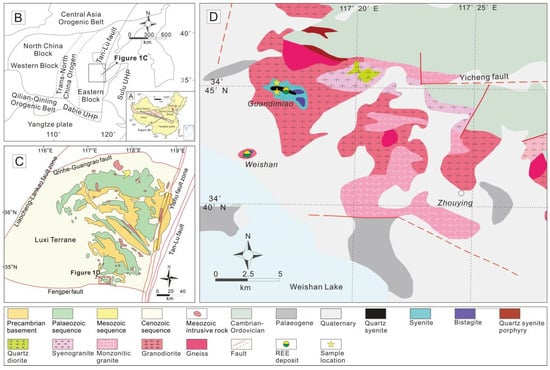
Figure 1.
(A) Simplified geological sketch map of China [8]. (B) Simplified geological sketch map of the major tectonic units of eastern China [23,24]. (C) Geological sketch map of the Luxi Terrane. (D) Geological sketch map of the southwest Luxi Terrane.
The Guandimiao area is located in the southwest Luxi Terrane (Figure 1D). The exposed formations in the area include Cambrian limestones and shales, Ordovician dolomites and limestones, and Quaternary clastic sediments. The Mesozoic Yanshanian magmatic activity is intensive, intruding into Archean granodiorites [7], and formed a series of magmatic rocks, including pyroxenites, hornblendites, dioritic porphyries, pyroxene syenites, quartz syenites, syenogranites and quartz monzonites.
3. Samples and Analytical Methods
The studied samples are collected from the Guandimiao REE deposit, and sample locations are marked in Figure 1D. Among them, the sample locations of the syenogranite (21XC01) and quartz syenites (21XC02, 21XC03, 21XC04, 21XC05) are 34°45′20″ N, 117°16′45″ E. The sample locations of the syenogranites (21XC07, 21XC08) and quartz monzonites (21XC06, 21XC09, 21XC10) are 34°44′54″ N, 117°16′50″ E. Ten samples, including three syenogranites, four quartz syenites and three quartz monzonites, were collected for geochemistry, and, among them, two samples (21XC01, 21XC06) were analyzed for sphene U-Pb dating.
3.1. Whole-Rock Geochemistry
Fresh samples were selected, crushed, and powdered to less than 200 mesh in an agate mill for whole-rock analysis. Geochemical data (major and trace elements) were obtained at the testing center of the Shandong Provincial Lunan Geology and Exploration Institute, China. Major elements were analyzed by X-ray fluorescence using a Rigaku RIX 2100 spectrometer with analytical uncertainties of 1–5%. Trace elements were determined using a PEE lan 6000 ICP-MS instrument with analytical uncertainties of 1–3%. Details of the analytical techniques are described in [25]. Analyses of basalt and andesite standard (BHVO-1, BCR-2, and AGV-1) indicated that the analytical precision and accuracy were better than 5% for major elements and 10% for trace elements and REEs [26].
3.2. Sphene LA-ICP-MS U-Pb Dating
The syenogranite and quartz monzonite samples were crushed to 40–60 mesh (250–380 μm) and sphene crystals were separated through standard magnetic and density separation techniques. Sphene grains were carefully handpicked under a binocular microscope, mounted in epoxy, polished down to near half-sections to expose internal structures, and then cleaned in an ultrasonic washer containing a 5% HNO3 bath. Prior to analysis, polished sections of sphene were carbon coated for Back-Scattered-Electron (BSE, Langfang Regional Geological Survey, Hebei, China) analyses using a JXA-880 electron microscope. Image analysis software was used under operating conditions of 20 kV and 20 nA, at the Langfang Regional Geological Survey, Hebei Province, China, to identify the internal structure and texture of all sphene crystals. Sphene samples were checked carefully using the microscope and BSE images for fluid inclusions and cracks. LA-ICP-MS analyses were conducted at the Isotopic Laboratory, Tianjin Center, China Geological Survey. Details of the analytical procedures are given in [27,28].
Laser sampling was performed using a Neptune double-focusing multiple-collector ICP-MS attached to a NEW WAVE 193 nm-FX ArF Excimer laser-ablation system. All analyses were conducted with a beam diameter of 35 μm, an 8 Hz repetition rate, and energy density of 11 J/cm2. GJ-1 was used as an internal standard for U-Pb dating analyses. NIST SRM 610 glass was used as an external standard to calculate U, Th, and Pb concentrations of sphene crystals. Every eight analyses were followed by two analyses of the standard zircon GJ-1. Isotopic ratios were calculated using ICPMSDataCal 8.4, China University of Geosciences, Wuhan, China [29] and were plotted using Isoplot version 3.0 software [30]. Common-Pb corrections were made following the methodology of [31].
4. Results
4.1. Petrography
The quartz syenites (21XC03, 21XC05) show light gray color, granular texture and massive structure (Figure 2A,B). The paragenesis of the quartz syenites are dominated by orthoclase (~60–61%), plagioclase (~24%), quartz (~6–9%), hornblende (~6–9%) and biotite (~1%) (Figure 3A–D). Accessory minerals include zircon, apatite and sphene. Orthoclase is subhedral to anhedral with crystal size of 180–3000 μm and typically show carlsbad twinning. Plagioclase is subhedral with crystal size of 200–2500 μm, shows polysynthetic twinning, and is partly altered sericite.
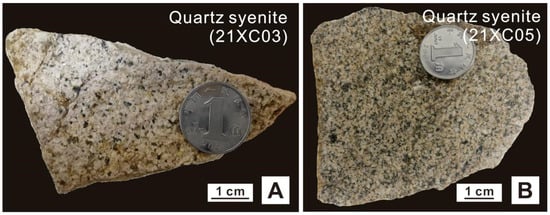
Figure 2.
Hand specimen photographs of the alkaline rocks. (A) Quartz syenite (21XC03); (B) Quartz syenite (21XC05).
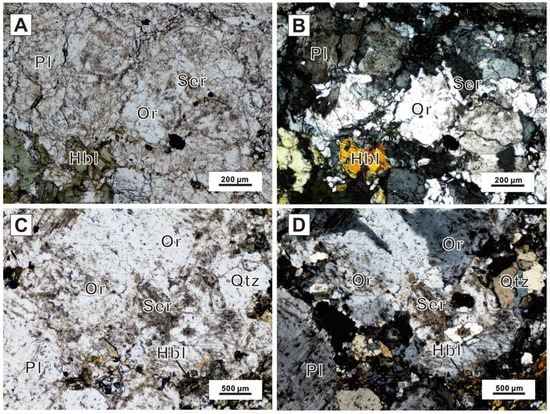
Figure 3.
Optical microscopy photomicrographs of the alkaline rocks. (A,B) Quartz syenite (21XC03); (C,D) Quartz syenite (21XC05). Mineral abbreviations: Pl—plagioclase; Or—orthoclase; Hbl—hornblende; Qtz—quartz; Srt—sericite. (A,C) plane-polarized light, (B,D) cross-polarized light.
4.2. Geochemistry
Syenogranite, quartz syenite and quartz monzonite show high SiO2 (61.6–74.9 wt.%), Al2O3 (11.8–14.3 wt.%), Na2O (5.26–6.60 wt.%) and Zr (251–441 ppm) concentrations, and low CaO (0.97–2.41 wt.%), MgO (0.33–1.90 wt.%), TiO2 (0.16–0.3 wt.%) and P2O5 (0.04–0.31 wt.%) content (Table 1). These rocks show a high R1 (4Si-11(Na+K)–2(Fe+Ti)) (934–2271) and R2 (6Ca+2Mg+Al) (374–496) ratios and correspond to quartz syenite and syenogranite compositions (Figure 4A). The studied samples, plotted in the alkalic and peralkaline fields, indicating that the complex is alkaline (Figure 4B,C). In terms of the alumina saturation index, the studied rocks are peralkaline ((Na+K)/Al>1; A/CNK: 0.75–0.88) (Figure 4D). Chondrite-normalized REE patterns of three syenogranites, four quartz syenites and three quartz monzonites show pronounced LREE enrichment, HREE depletion and slightly positive Eu anomalies (Eu/Eu*: 1.00–1.14) with high ratios for (Gd/Yb)N: 6.1–12.6, (La/Yb)N: 59.6–131.9 and (La/Sm)N: 4.6–6.1 (Figure 5A). Primitive mantle-normalized trace element patterns show enrichment in large ion lithophile elements (LILEs) Rb and Ba, and depletion in high-field-strength elements (HFSEs) Nb, Ta, Ti (Figure 5B).

Table 1.
Major and trace element compositions for the alkaline rocks.
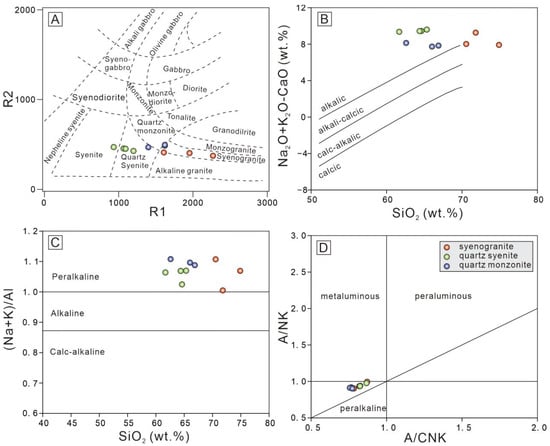
Figure 4.
Geochemical classification plots of the syenogranite, quartz syenite and quartz monzonite. (A) R2 (6Ca + 2Mg + Al) vs. R1 (4Si—11(Na + K)—2(Fe + Ti)) plot for classifying the rock types [32]. (B) (Na2O + K2O—CaO) vs. SiO2 [33] classification diagram for evaluating the calcic to alkalic variations. (C) (Na + K)/Al vs. SiO2 plot [34]. (D) A/NK [molar Al2O3/(Na2O + K2O)] vs. A/CNK [molar Al2O3/(CaO + Na2O + K2O)] for evaluating peralkaline, metaluminous and peraluminous melt compositions [35].
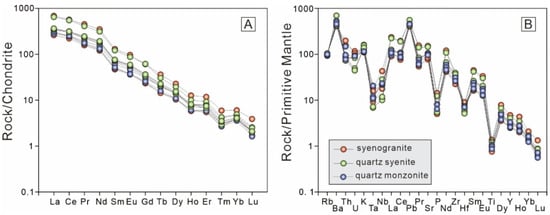
Figure 5.
(A) Chondrite-normalized REE patterns [36]; (B) Primitive mantle-normalized trace element patterns [37].
4.3. Sphene U-Pb Geochronology
Two samples were dated for sphene U-Pb geochronology, syenogranite and quartz monzonite, with LA-ICP-MS data given in Table 2, the morphology shown in Figure 6 and data plotted in Figure 7.

Table 2.
LA-ICP-MS sphene U-Pb isotope data of syenogranite and quartz monzonite.

Figure 6.
BSE image of sphene grains from syenogranite and quartz monzonite. The red circles indicate spots of LA-ICP-MS U-Pb dating.
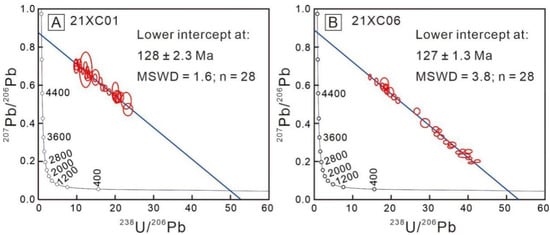
Figure 7.
Sphene U-Pb lower intercept ages plots: (A) for syenogranite; (B) for quartz monzonite.
Sphene grains from syenogranite (21XC01) are euhedral–subhedral and range from 180 to 300 μm in size, with length-to-width ratios of from 1:1 to 2:1 (Figure 6). Twenty-eight spots were analyzed on 28 grains. The 28 analyses yield lower intercept dates of 128 ± 2.3 Ma (2σ, n = 28, MSWD = 1.6) (Figure 7A). The Th contents range from 163 to 505 ppm and U contents range from 22 to 110 ppm. They show Th/U ratios of 4.4 to 10.3 (Table 2).
Sphene grains in quartz monzonite (21XC06) are subhedral in shape, with a length of 100–200 μm and aspect ratio of 1:1 to 2:1 (Figure 6). Twenty-eight spots were analyzed on 28 grains. The analyzed spots yield lower intercept dates of 127 ± 1.3 Ma on a Tera–Wasserburg diagram (2σ, n = 28, MSWD = 3.8) (Figure 7B). They show Th and U contents of from 244 to 462 ppm and 48 to 298 ppm. The Th/U ratios range from 1.2 to 6.9 (Table 2).
4.4. Trace Element Geochemistry of Sphene
Sphene REE data from the syenogranite (21XC01) shows the high total REE, respectively ranging from 26,594 to 44,233 ppm and 25,538 to 42,146 ppm, and low HREE content of 953 to 2267 ppm (Table 3). All REE data from syenogranite exhibit similar chondrite-normalized REE patterns with pronounced LREE enrichment and HREE depletion, strong fractionation from LREE to HREE ((La/Yb)N = 26–81) and HREE ((Gd/Yb)N = 4–13), with slightly negative Eu anomalies (Eu/Eu* = 0.66–1.06) (Figure 8A).

Table 3.
Trace-element compositions for the sphene in the alkaline rocks (ppm).
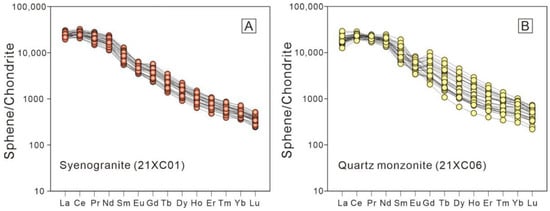
Figure 8.
Chondrite-normalized REE patterns plots: (A) for sphene in syenogranite (21XC01); (B) for sphene in quartz monzonite (21XC06).
Total REE content of sphene from the quartz monzonite (21XC06) ranges from 26,550 ppm to 39,149 ppm. The LREE and HREE contents range from 25,477 ppm to 35,757 ppm, 788 ppm to 4182 ppm, respectively (Table 3). Chondrite-normalized REE patterns of the sphene in quartz monzonite show pronounced LREE enrichment, HREE depletion, strong fractionation of LREE/HREE ((La/Yb)N = 14–96) and discrete Eu anomalies (Eu/Eu* = 0.44–1.35) (Figure 8B). The HREE exhibit strong fractionation ((Gd/Yb)N = 3–14) with variable enrichment comparable to the syenogranite.
5. Discussion
5.1. Early Cretaceous Alkaline Magmatism in the Luxi Terrane
Sphene grains from syenogranite (21XC01) and quartz monzonite (21XC06) are euhedral–subhedral, with lengths of 100–300 μm (Figure 6), and the chondrite-normalized REE patterns show pronounced LREE enrichment, and HREE depletion, implying a magmatic origin (Figure 8) [38,39,40,41]. The Th/U ratios of the sphenes from the syenogranite and quartz monzonite are relatively high (>1) [39,40,41,42], supporting the magmatic origin. The sphene trace element data mostly fall in the magmatic field (Figure 9), which further implies a magmatic origin. Therefore, the lower intercept age of 127–128 Ma from the sphenes in syenogranite and quartz monzoite represent the crystallization age [43]. Liu et al. [7] reported LA-ICP-MS zircon U-Pb age of 128 Ma from pyroxene syenite in Guandimiao alkaline complex, which is consistent with the calculated sphene ages in this study. Therefore, the crystallization ages of alkaline rocks in the Guandimiao complex are bracketed in the range of 127–128 Ma.
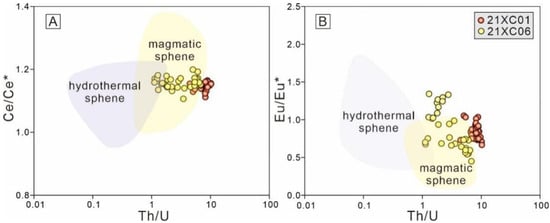
Figure 9.
Sphene origin discrimination diagrams. (A) Ce/Ce* vs. Th/U [42] and (B) Eu/Eu* vs. Th/U [42] for the sphene from syenogranite and quartz monzonite.
Liang et al. [6] reported zircon U-Pb ages of 122–130 Ma for the quartz syenite and aegirine-augite syenite from the Weishan complex. Zircon grains from the quartz syenite and alkaline granites of the Weishan complex were dated by LA-ICP-MS at 125–127 Ma [9], and crystallization ages of 129–131 Ma were given for the Longbaoshan alkaline rocks by Lan et al. [8]. Hence, the Early Cretaceous alkaline magmatism in the Luxi Terrane occurred from 122 to 131 Ma, and formed a series of alkaline rocks.
5.2. Petrogenesis and Magma Origin
The Guandimiao complex consists of pyroxenites, hornblendites, dioritic porphyries (128 Ma), pyroxene syenites (128 Ma), quartz syenites, syenogranites (128 Ma) and quartz monzonites (127 Ma) with different compositions varying from ultramafic to acidic rocks [7,10], which may suggest the fractional crystallization model. To address the fractional crystallization process, we discussed the previously published hornblendite and the alkaline rocks in this study [7]. The negative correlations between major elements and SiO2 suggest that the alkaline rocks are likely the result of fractional crystallization during magmatic evolution (Figure 10) [6,44]. The decreases in CaO, Fe2O3 (Total) and MgO with increasing of SiO2 were probably caused by the fractional crystallization of hornblende and biotite (Figure 10A-C), which is consistent with the occurrence of hornblende and biotite in the Guandimiao complex. The negative correlation between SiO2 and P2O5 implies the crystallization of apatite (Figure 10D), which is consistent with the occurrence of apatite. The differences in the HREE patterns indicate that the magma source is highly evolved, and silica and titanium are unsaturated in the quartz monzonite (Figure 8). The negative anomalies of the Nb, Ta and Ti are accounted for in the crystallization rutile and sphene (Figure 5B). The alkaline rocks contain abundant sphene and no rutile. Furthermore, the TiO2 contents decrease with increases in SiO2, implying that ilmenite and rutile may form as restite during the early fractional crystallization, while sphene formed during the later stage (Figure 10E). In summary, the major and trace-element geochemistry indicates that fractional crystallization played an important role in the formation of the alkaline rocks.
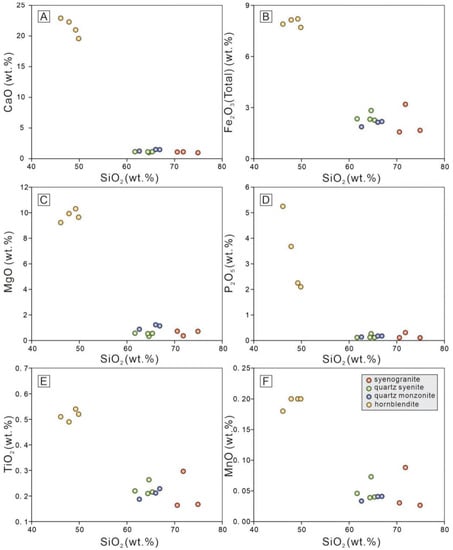
Figure 10.
(A–F) SiO2 vs. selected major elements showing variable trends for hornblendite, syenogranite, quartz syenite and quartz monzonite [8]. Major elements contents of hornblendite are taken from [7].
Since the La/Hf, Th/V, Ce/Yb and Tb/Yb ratios are sensitive to magmatic processes, they can be used to determine the different magmatic processes, including the partial melting and fractional crystallization [18,21,45]. On the La/Hf-La, Th-Th/V, Ce/Yb-K2O and Tb/Yb-Yb discrimination diagrams (Figure 11), the alkaline rocks under examination exhibit a positive correlation between La/Hf and La, Th and Th/V, Ce/Yb and K2O, and Tb/Yb and Yb, which are consistent with the partial melting trend, demonstrating the role of partial melting in generating the alkaline melts.
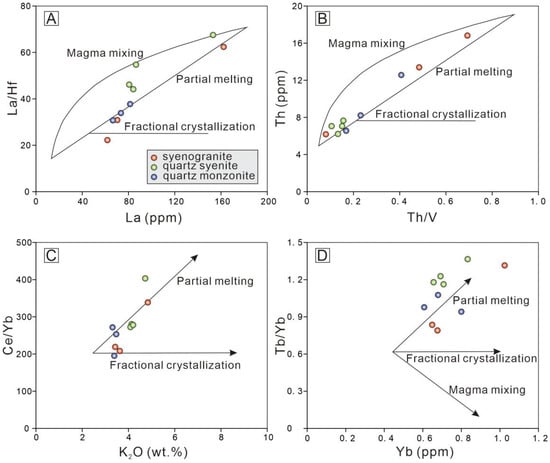
Figure 11.
Compositional variation diagrams of (A) La/Hf vs. La [45], (B) Th vs. Th/V [45], (C) Ce/Yb vs. K2O [21] and (D) Tb/Yb vs. Yb [21] for the alkaline rocks showing partial melting.
The alkaline rocks represent Rb/Nb ratios between 2.00 and 9.06 (average 5.07), which are close to the crust ratios (5.36–6.55) and significantly higher than the mantle ratios (0.24–0.89). Therefore, the Rb/Nb ratios of the alkaline rocks support crustal contamination to some degree. The alkaline rocks show (Th/Nb)N ratios 1.69 to 11.16, implying that the alkaline rocks have assimilated crustal material ((Th/Nb)N > 1) [46]. In addition, the Nb/Th ratio is considered a critical indicator for crustal contamination processes [36]. The alkaline rocks with Nb/Th ratios between 0.75 and 4.95 are further consistent with those observed in the crust (~1.1), which substantiate the involvement of crustal material. The crustal contamination is further supported by the presence of inherited zircon grains (2553–2178 Ma) in the Guandimiao pyroxene syenite [7].
The Nb/Ta ratios (18.1–46.9) of the alkaline rocks are higher than the ratios of average crust (12–13) [47], which is consistent with the mantle source (15.5–19.5) [46], implying a mantle origin. Seven samples show Y/Nb ratios of lower than 1.2, which is also consistent with a mantle source (<1.2) [48,49,50], implying that the primary alkaline magma derived from the mantle. The La/Nb and La/Ta ratios (4.1–11.8, and 87–355 respectively) are close to the lithospheric mantle (La/Nb>1), and significantly higher than the ratios of the asthenosperic mantle (La/Nb = ~0.7, and La/Ta = ~10 respectively), implying lithospheric mantle origin [51,52]. These alkaline rocks fall within or near the enriched mantle field (Figure 12), which further implies the lithospheric mantle origin [53]. Three samples of the alkaline rocks with Y/Nb ratios higher than 1.2 are consistent with a crustal source (>1.2) [49,50], which may be the result of crustal assimilation during magma emplacement. Zircon grains in the Weishan alkaline rocks display negative εHf(t) values ranging from −22.67 to −13.19 and yield a TDMC of 2036–2617 Ma, suggesting that the Weishan alkaline rocks originated from the lithospheric mantle with the assimilation of crustal material [6,9]. The Guandimiao and Weishan alkaline rocks show a close spatial relationship and crystallization ages, suggesting the magma may have derived from the same source [6,9]. The magma source of the alkaline rocks in the Guandimiao complex originated from the partial melting of lithospheric mantle, which experienced fractional crystallization and crustal contamination processes during its emplacement.
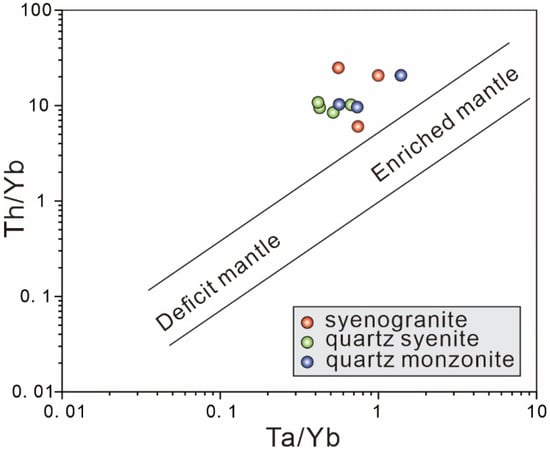
Figure 12.
Magma origin discrimination diagram [53].
5.3. Tectonic Implications
The crystallization ages of the alkaline rocks from the Luxi Terrane are in the range of 122–131 Ma, corresponding to the peak time of lithospheric destruction of the NCB (120–130 Ma) [54,55]. In addition, the lithospheric destruction mainly occurred in eastern NCB due to the subduction of the Izanagi plate during the Early Cretaceous [42,56,57,58,59,60,61,62,63,64,65,66,67,68]. Hence, the subducting Izanagi plate during the Late Mesozoic may have played an important role in the lithospheric destruction of the NCB. The Izanagi plate subducted beneath the NCB during the Jurassic, resulting in the thickening of the lower crust [60,61,62]. Asthenosphere upwelling and partial melting of the lithospheric mantle were caused by the rollback of the subducting Izanagi plate during the Early Cretaceous [59,62,63,64,65,66].
The alkaline rocks show enrichment in LREE and LILEs (Rb and Ba), depletion in HREE and HFSEs (Nb, Ta, Ti) characteristics that correspond to volcanic arc granites [42,67,68,69]. In the tectonic discrimination diagram, the alkaline rocks are mainly plotted in the volcanic arc granites field (Figure 13A–C), which further implies that they were formed in a volcanic arc setting. The alkaline rocks in the Guandimiao complex mainly include syenogranites, quartz syenites and quartz monzonites, which are consistent with active continental margin granites [42]. Furthermore, in the Th/Yb-Yb diagram, the alkaline rocks are mainly plotted in the active continental margin field (Figure 13D) [42]. Hence, the alkaline rocks were probably formed in or near the active continental margin. The active continental margin affinity may be related to the subduction of the Yangtze or Izanagi plate beneath the NCB.
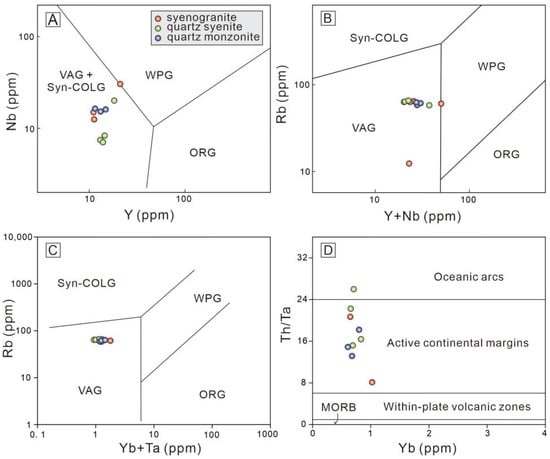
Figure 13.
Tectonic implications discrimination diagrams (A) Nb vs. Y, (B) Rb vs. (Y + Nb) [70], (C) Rb vs. (Yb + Ta), (D) Th/Ta vs. Yb [48]. Abbreviations: VAG: Volcanic arc granites, Syn-COLG: Syn-collisional granites, WPG: Within plate granites, ORG: Ocean ridge granites.
The alkaline rocks in the Guandimiao complex are alkali and peralkaline, and show high Ga/Al ratios, SiO2, LREE, Zr and Nb, and low MgO, CaO, Eu contents, which, together with the high abundance of alkali feldspar, are similar to typical A-type granites [42,48,49]. In the tectonic discrimination diagrams (Figure 14), all the alkaline rocks are plotted in the A-type granite field, which further supports that the alkaline rocks are A-type granites. Therefore, the parent magma of the alkaline rocks from the Guandimiao complex is anhydrous, and may have been formed in an anorogenic setting [68]. The alkaline rocks are A-type granites, indicating an extensional decompression process during the magma emplacement [70,71,72,73,74]. Previous studies show that the Izanagi plate subduction might have played an important role in the magmatic activity of the eastern NCB during the Early Cretaceous [69]. Therefore, the alkaline rocks in the Guandimiao complex were probably formed in an extensional back-arc setting induced by the retreat of the subducting Izanagi plate [69,75].

Figure 14.
(A–C) Rock-type discrimination diagrams [46].
In summary, the rollback of the subducting Izanagi plate during the Early Cretaceous triggered the asthenosphere upwelling and lithospheric thinning and partial melting of the lithospheric mantle [76,77,78]. The lithospheric mantle-derived magma was emplaced at a shallower crustal depth and contaminated by crustal material during ascending, and underwent a fractional crystallization process to form the Guandimiao alkaline rocks (Figure 15).
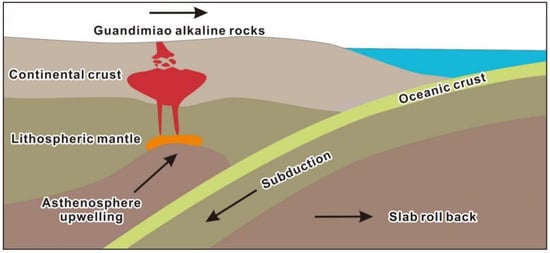
Figure 15.
Evolution of the alkaline rocks in the Guandimiao area during the Early Cretaceous [76,77,78].
6. Conclusions
- (1)
- The sphenes from syenogranite and quartz monzonite show an euhedral–subhedral morphology, which, together with the obvious fractionation between LREE and HREE and high Th/U ratios, imply a magmatic origin.
- (2)
- Sphene U-Pb geochronology indicates that the alkaline rocks in the Guandimiao complex are the products of the Early Cretaceous alkaline magmatism in the Luxi Terrane.
- (3)
- The magma source of the alkaline rocks in the Guandimiao complex originated from the partial melting of lithospheric mantle, which experienced fractional crystallization and crustal contamination processes during its emplacement.
- (4)
- The Guandimiao alkaline complex probably formed in an extensional back-arc setting and the magma upwelling are induced by the retreat of the subducting Izanagi plate.
Author Contributions
Conceptualization: K.-F.Q.; writing: Z.-C.X.; review and editing: C.-L.Z. and Z.S.; formal analysis: S.-S.L. and Y.-Q.H. All authors have read and agreed to the published version of the manuscript.
Funding
This research was funded by the Open Funding of Shandong Provincial Lunan Geology and Exploration Institute (LNY2020-Z02, LNYS202101), the Open Research Project from Key Laboratory of Metallogeny and Mineral Assessment, Institute of Mineral Resources, CAGS (ZS2009), Innovation and Entrepreneurship Training Program of China University of Geosciences, Beijing (S202111415020), the Beijing Nova Program (Z201100006820097), the 111 Project (BP0719021) and Chinese Postdoctoral Science Foundation (2021M692995).
Acknowledgments
The authors thank Dengyang He for his help in comments.
Conflicts of Interest
The authors declare no conflict of interest.
References
- Song, M.C.; Yu, X.S.; Song, Y.X.; Xiao, B.J.; Zhou, D.S.; Gao, C.S.; Feng, A.P. Types, sources, and regional crust-mantle evolution background of diamonds in the western Shandong Province. Acta Geol. Sin. 2020, 94, 2606–2625. [Google Scholar]
- Guo, P. Geodynamic Setting of Mesozoic Gold Metallogeny in the Western Shandong Province. Ph.D. Thesis, China University of Geosciences, Beijing, China, May 2014. [Google Scholar]
- Goldfarb, R.J.; Mao, J.W.; Qiu, K.F.; Goryachev, N. The great Yanshanian metallogenic event of eastern Asia: Consequences from one hundred million years of plate margin geodynamics. Gondwana Res. 2021, 100, 223–250. [Google Scholar] [CrossRef]
- Lan, T.G.; Fan, H.R.; Hu, F.F.; Yang, K.F.; Wang, Y. Genesis of the Weishan REE deposit, Shandong Province: Evidences from Rb-Sr isochron age, LA-MC-ICPMS Nd isotopic compositions and fluid inclusions. Geochimica 2011, 40, 428–442. [Google Scholar]
- Xie, Y.L.; Xia, J.M.; Cui, K.; Qu, Y.W.; Liang, P.; Zhong, R.C. Rare earth elements deposits in China: Spatio-temporal distribution and ore-forming processes. Chin. Sci. Bull. 2020, 65, 3794–3808. [Google Scholar] [CrossRef]
- Liang, Y.W.; Lai, Y.; Hu, H.; Zhang, F. Zircon U-Pb Ages and Geochemical Characteristics Study of Syenite from Weishan REE Deposit, Western Shandong. Acta Sci. Nat. Univ. Pekin. 2017, 53, 652–666. [Google Scholar]
- Liu, H.; Yu, L.; Chen, H.J.; Qiu, C.G.; Luo, H.D.; Yu, L.S.; Gao, Y.X. Zircon U-Pb Geochronology, Geochemistry and Geological Significance of Guandimiao Complex Intrusion in the East China Craton. Miner. Depos. 2022, in press.
- Lan, T.G.; Fan, H.R.; Hu, F.F.; Tomkins, A.G.; Yang, K.F.; Liu, Y.S. Multiple crust-mantle interactions for the destruction of the North China Block: Geochemical and Sr-Nd-Pb-Hf isotopic evidence from the Longbaoshan alkaline complex. Lithos 2011, 122, 87–106. [Google Scholar] [CrossRef]
- Wei, P.F.; Yu, X.F.; Li, D.P.; Liu, Q.; Yu, L.D.; Li, Z.S.; Geng, K.; Zhang, Y.; Sun, Y.Q.; Chi, N.J. Geochemistry, Zircon U-Pb Geochronology, and Lu-Hf Isotopes of the Chishan Alkaline Complex, Western Shandong, China. Minerals 2019, 9, 293. [Google Scholar] [CrossRef] [Green Version]
- Zhi, C.L.; An, M.G.; Huang, K.P.; Shang, Z.; Meng, X.W. Magmatic rock type in Chishan-Longbaoshan area, Shandong Province. Investigation and evaluation design of rare earth mineral resources. 2020; (Unpublished work). [Google Scholar]
- Wu, M.Q.; Samon, I.M.; Qiu, K.F.; Zhang, D.H. Multistage metasomatic Zr mineralization in the world-class Baerzhe Rare earth element-Nb-Zr-Be deposit. Am. Mineral. 2022. [Google Scholar] [CrossRef]
- Mao, J.W.; Franco, P.; Nigel, C. Mesozoic metallogeny in East China and corresponding geodynamic settings: An introduction to the special issue. Ore Geol. Rev. 2011, 43, 1–7. [Google Scholar] [CrossRef]
- Long, Z.Y.; Qiu, K.F.; Santosh, M.; Yu, H.C.; Jiang, X.Y.; Zou, L.Q.; Tang, D.W. Fingerprinting the metal source and cycling of the world’s largest antimony deposit in Xikuangshan, China. GSA Bull. 2022; in press. [Google Scholar] [CrossRef]
- Xu, Y.G.; Huang, X.L.; Ma, J.L. Crust-mantle interaction during the tectono-thermal reactivation of the North China Block: Constraints from SHRIMP zircon U-Pb chronology and geochemistry of Mesozoic plutons from western Shandong. Contrib. Mineral. Pet. 2004, 147, 750–767. [Google Scholar] [CrossRef]
- Wu, M.Q.; Samson, I.M.; Qiu, K.F.; Zhang, D.H. Concentration mechanisms of REE-Nb-Zr-Be mineralization in the Baerzhe deposit, NE China: Insights from textural and chemical features of amphibole and rare-metal minerals. Econ. Geol. 2021, 116, 651–679. [Google Scholar] [CrossRef]
- Hu, Q.Y.; Li, L.; Tang, Z.B.; Shi, X.P. Characteristics and mechanism of Late Mesozoic extensional faults in West Shandong Uplift. Geol. China 2009, 36, 1233–1244. [Google Scholar]
- Li, Y. A Comparative Study of the 1800-1600 Ma Mafic Dike Group in North China: A Case Study of Western Shandon. Master’s Thesis, University of Chinese Academy of Sciences, Beijing, China, 2014. [Google Scholar]
- Yu, H.C.; Qiu, K.F.; Hetherington, C.J.; Chew, D.; Huang, Y.Q.; He, D.Y.; Geng, J.Z.; Xian, H.Y. Apatite as an alternative petrochronometer to trace the evolution of magmatic systems containing metamict zircon. Contrib. Mineral. Pet. 2021, 176, 68. [Google Scholar] [CrossRef]
- Ma, M.Z.; Wan, Y.S.; Xie, H.Q.; Liu, S.J.; Xie, S.W.; Dong, C.Y.; Bai, W.Q.; Li, Y.; Wang, Y.Q. Neoarchean Mafic Magmatism in Qixingtai Area, West Shandong: Formation Ages and Compositions of Meta-Gabbros. J. Earth Sci. 2020, 45, 2610–2628. [Google Scholar]
- Qiu, K.F.; Yu, H.C.; Deng, J.; McIntire, D.; Gou, Z.Y.; Geng, J.Z.; Chang, Z.S.; Zhu, R.; Li, K.N.; Goldfarb, R. The giant Zaozigou Au-Sb deposit in West Qinling, China: Magmatic- or metamorphic-hydrothermal origin? Miner. Depos. 2020, 18, 345–362. [Google Scholar] [CrossRef]
- Shi, W.J. The Late Mesozoic Tectonic-magematic Evolution Process in the Yishu Fault Zone and Adjacent Regions, Shandong Province: Implication for Gold Mineralization. Ph.D. Thesis, China University of Geosciences, Wuhan, China, May 2014. [Google Scholar]
- Qiu, K.F.; Goldfarb, R.J.; Deng, J.; Yu, H.C.; Gou, Z.Y.; Ding, C.J.; Wang, Z.K.; Li, D.P. Gold deposits of the Jiaodong Peninsula, eastern China. Soc. Econ. Geol. Spec. Publ. 2020, 23, 753–773. [Google Scholar]
- Zhao, G.C.; Wilde, S.A.; Cawood, P.A.; Sun, M. Archean blocks and their boundaries in the North China Craton: Lithological, geochemical, structural and P-T path constraints and tectonic evolution. Precambr. Res. 2001, 107, 45–73. [Google Scholar] [CrossRef]
- Zhang, H.F.; Sun, M.; Zhou, X.H.; Ying, J.F. Geochemical constraints on the origin of Mesozoic alkaline intrusive complexes from the North China Craton and tectonic implications. Lithos 2005, 81, 297–317. [Google Scholar] [CrossRef]
- Zhang, S.H.; Zhao, Y.; Li, X.H.; Ernst, R.E.; Yang, Z.Y. The 1.33-1.30 Ga Yanliao large igneous provice in the North China Craton: Implications for reconstruction of the Nuna (Columbia) supercontinent, and specifically with the North Australian Craton. Earth Planet. Sci. Lett. 2017, 465, 112–125. [Google Scholar]
- Rudnick, R.L.; Gao, S.; Ling, W.L.; Liu, Y.S.; Mcdonough, W.F. Petrology and geochemistry of spinel peridotite xenoliths from Hannuoba and Qixia. North China craton. Lithos 2004, 77, 609–637. [Google Scholar] [CrossRef]
- Geng, J.Z.; Qiu, K.F.; Gou, Z.Y.; Yu, H.C. Tectonic regime switchover of Triassic Western Qinling Orogen: Constraints from LA-ICP-MS zircon U-Pb geochronology and Lu-Hf isotope of Dangchuan intrusive complex in Gansu. China. Geochemistry 2017, 77, 637–651. [Google Scholar] [CrossRef]
- Qiu, K.F.; Yu, H.C.; Wu, M.Q.; Geng, J.Z.; Ge, X.K.; Gou, Z.Y.; Taylor, R.D. Discrete Zr and REE mineralization of the Baerzhe rare-metal deposit, China. Am. Mineral. 2019, 104, 1487–1502. [Google Scholar] [CrossRef]
- Liu, Y.S.; Gao, S.; Hu, Z.C.; Gao, C.G.; Zong, K.Q.; Wang, D.B. Continental and oceanic crust recycling-induced melt-peridotite interactions in the Trans-North China Orogen: U-Pb dating, Hf isotopes and trace elements in zircons from mantle xenoliths. J. Pet. 2010, 51, 537–571. [Google Scholar] [CrossRef]
- Ludwig, K.R. ISOPLOT 3.00: A Geochronological Toolkit for Microsoft Excel; Berkeley Geochronology Center: Berkeley, CA, USA, 2003; p. 39. [Google Scholar]
- Anderson, T. Correction of common lead in U-Pb analyses that do not report 204Pb. Chem. Geol. 2002, 192, 59–79. [Google Scholar] [CrossRef]
- De la Roche, H.; Leterrier, J.; Grandclaude, P.; Marchal, M. A classification of volcanic and plutonic rocks using R1R2-diagram and major-element analyses—Its relationships with current nomenclature. Chem. Geol. 1980, 29, 183–210. [Google Scholar] [CrossRef]
- Frost, B.R.; Barnes, C.G.; Collins, W.J.; Arculus, R.J.; Ellis, D.J.; Frost, C.D. A geochemical classification for granitic rocks. J. Pet. 2001, 42, 2033–2048. [Google Scholar] [CrossRef]
- Frost, C.D.; Frost, B.R. On Ferroan (A-type) Granitoids: Their Compositional Variability and Modes of Origin. J. Pet. 2011, 52, 39–53. [Google Scholar] [CrossRef] [Green Version]
- Shand, S.J. Eruptive Rocks; John Wiley and Sons: Hoboken, NJ, USA, 1943; 444p. [Google Scholar]
- Sun, S.S.; McDonough, W.F. Chemical and isotopic systematics of oceanic basalts: Implications for mantle composition and processes. Geol. Soc. Spec. Publ. 1989, 42, 313–345. [Google Scholar] [CrossRef]
- McDonough, W.F.; Sun, S. The composition of the Earth. Chem. Geol. 1995, 120, 223–253. [Google Scholar] [CrossRef]
- Pan, H.B.; Kang, Z.Q.; Yang, F.; Fu, W.C. A preliminary study on the paramineralsphene from the subyingan porphyry in Dabaoshan, northern Guangdong. Geol. Sci. Technol. Inf. 2014, 33, 2014. [Google Scholar]
- Deng, X.D.; Li, J.W.; Zhou, M.F.; Zhao, X.F.; Yan, D.R. In-situ LA-ICPMS trace elements and U-Pb analysis of titanite from the Mesozoic Ruanjiawan W-Cu-Mo skarn deposit, Daye district, China. Ore Geol. Rev. 2015, 65, 990–1004. [Google Scholar] [CrossRef]
- Fu, Y.; Sun, X.M.; Lin, H.; Yang, T.J. In-situ LA-ICP-MS U-Pb geochronology and trace elements analysis of polygenetic titanite from the giant Beiya gold-polymetallic deposit in Yunnan Province, Southwest China. Ore Geol. Rev. 2016, 77, 43–56. [Google Scholar] [CrossRef]
- Fu, Y.; Sun, X.M.; Hollings, P.; Li, D.F.; Yang, T.J. Geochronology and trace element geochemistry of titanite in the Machangqing Cu-Mo-dominated polymetallic deposit, Yunnan Province, Southwest China. J. Asian Earth Sci. 2018, 158, 398–414. [Google Scholar] [CrossRef]
- Pearce, J.A.; Harris, N.B.W.; Tindle, A.G. Trace Element Discrimination Diagrams for the Tectonic Interpretation of Granitic Rocks. J. Pet. 1984, 25, 956–983. [Google Scholar] [CrossRef] [Green Version]
- Jin, M.Q.; Li, Y.G.; Wang, P.; Wang, S.S.; Li, W.L. Element fractionation and correction method for U-Pb dating of titanite by laser ablation-inductively coupled plasms-mass spectrometry. Rock Miner. Anal. 2020, 39, 274–284. [Google Scholar]
- Wu, F.Y.; Jahn, B.M.; Wilde, S.A.; Lo, C.H.; Yui, T.F.; Lin, Q.; Ge, W.C.; Sun, D.Y. Highly fractionated I-type granites in NE China (I): Geochronology and petrogenesis. Lithos 2003, 66, 241–273. [Google Scholar] [CrossRef]
- Abdallsamed, M.I.M.; Wu, Y.B.; Zhang, W.X.; Zhou, G.Y. Paleozoic peralkaline A-type magmatism of the Tongbai Orogen, Central China: Petrogenesis and tectonic implications. Lithos 2018, 322, 268–280. [Google Scholar] [CrossRef]
- Xia, L.Q.; Xia, Z.C.; Xu, X.Y.; Li, X.M.; Ma, Z.P. The discrimination between continental basalt and island arc basalt based on geochemical method. Acta Petrol. Mineral. 2007, 26, 77–89. [Google Scholar]
- Barth, M.G.; McDonough, W.F.; Rudnick, R.L. Tracking the budget of Nb and Ta in the continental crust. Chem. Geol. 2000, 165, 197–213. [Google Scholar] [CrossRef]
- Kamber, B.S.; Collerson, K.D. Role of “hidden” deeply subducted slabs in mantle depletion. Chem. Geol. 2000, 166, 241–254. [Google Scholar] [CrossRef]
- Eby, G.N. The A-type granitoids: A review of their occurrence and chemical characteristics and speculations on their petrogenesis. Lithos 1990, 26, 115–134. [Google Scholar] [CrossRef]
- Eby, G.N. Chemical subdivision of A-type granitoids: Petrogenetic and tectonic implications. Geology 1992, 20, 641–644. [Google Scholar] [CrossRef]
- De Paolo, D.J.; Daley, E.E. Neodymium isotopes in basalts of the southwest basin and range and lithospheric thinning during continental extension. Chem. Geol. 2000, 169, 157–185. [Google Scholar] [CrossRef]
- Thomson, R.N.; Morrison, M.A. Asthenospheric and lower lithospheric mantle contributions to continental extentional mgmatism: An example from the British Tertiary Province. Chem. Geol. 1988, 68, 1–15. [Google Scholar] [CrossRef]
- Wilson, M. Igneous Petrogenesis: A Global Tectonic Approach; Unwin Hyman: London, UK, 1989; 466p. [Google Scholar]
- Minzies, M.A.; Xu, Y.; Zhang, H.; Fan, W. Integration of geology, geophysics and geochemistry: A key to understanding the North China Craton. Lithos 2007, 96, 1–21. [Google Scholar] [CrossRef]
- Zhu, R.; Xu, Y.; Zhu, G.; Zhang, H.; Xia, Q.; Zheng, T. Destruction of the North China Craton. Sci. China Earth Sci. 2012, 55, 1565–1587. [Google Scholar] [CrossRef]
- Pan, F.B.; Liu, R.; Jin, C.; Jia, B.J.; He, X.B.; Gao, Z.; Tao, L.; Zhou, X.C.; Zhang, L.Q. Petrogenesis of Early Cretaceous granitoids from southwest Zhejiang, NE South China Block and its geodynamic implication. Lithos 2018, 308, 196–212. [Google Scholar] [CrossRef]
- Zhang, H.; Sun, M.; Zhou, M.; Fan, W.; Zhou, Z.; Zhai, M. Highly heterogeneous Late Mesozoic lithospheric mantle beneath the North China Craton: Evidence from Sr-Nd-Pb isotopic systematics of mafic igneous rocks. Geol. Mag. 2004, 141, 55–62. [Google Scholar]
- Zhai, M.; Fan, Q.; Zhang, H.; Sui, J.; Shao, J. Lower crustal processes leading to Mesozoic lithospheric thinning beneath eastern North China: Underplating, replacement and delamination. Lithos 2007, 96, 36–54. [Google Scholar] [CrossRef]
- Golonka, J. Phanerozoic Paleoenvironment and Paleolithofacies Maps. Mesozoic. Geologia 2007, 33, 211–264. [Google Scholar]
- Zheng, Y.F.; Xu, Z.; Zhao, Z.F.; Dai, L.Q. Mesozoic mafic magmatism in North China: Implications for thinning and destruction of cratonic lithosphere. Sci. China Earth Sci. 2018, 61, 353–385. [Google Scholar] [CrossRef]
- Zhu, R.X.; Xu, Y.G. The subduction of the west Pacific plate and the destruction of the North China Craton. Sci. China Earth Sci. 2019, 62, 1340–1350. [Google Scholar] [CrossRef]
- Liu, Y.; Wei, J.H.; Zhang, D.H.; Chen, J.J.; Zhang, X.M. Early Cretaceous Wulong intermediate-mafic dike swarms in the Liaodong Peninsula: Implications for rapid lithospheric delamination of the North China Craton. Lithos 2020, 362, 105473. [Google Scholar] [CrossRef]
- Huang, Y.Q.; Wu, M.Q.; Germain, B.; Yu, H.C.; Qiao, B.X.; Zhao, Z.G.; Qiu, K.F. Geodynamic setting and ore formation of the Younusisayi thorium deposit in the Altyn orogenic belt, NW China. Ore Geol. Rev. 2021, 140, 104552. [Google Scholar] [CrossRef]
- Yang, F.; Santosh, M.; Glorie, S.; Jepson, G.; Xue, F.; Kim, S.W. Meso-Cenozoic multiple exhumation in the Shandong Peninsula, eastern North China Craton: Implications for lithospheric destruction. Lithos 2020, 370, 105597. [Google Scholar] [CrossRef]
- Hou, M.L.; Jiang, Y.H.; Jiang, S.Y.; Ling, H.F.; Zhao, K.D. Contrasting origins of late Mesozoic adakitic granitoids from the northwestern Jiaodong Peninsula, East China: Implications for crustal thickening to delamination. Geol. Mag. 2007, 144, 619–631. [Google Scholar] [CrossRef]
- Zhang, H.F.; Sun, M.; Zhou, X.H.; Fan, W.M.; Zhai, M.G.; Yin, J.F. Mesozoic lithosphere destruction beneath the North China Craton: Evidence from major-, trace-element and Sr-Nd-Pb isotope studies of Fangcheng basalts. Contrib. Mineral. Pet. 2002, 144, 241–254. [Google Scholar] [CrossRef]
- Li, S.R.; Santosh, M. Metallogeny and craton destruction: Records from the North China Craton. Ore Geol. Rev. 2014, 56, 376–414. [Google Scholar] [CrossRef]
- Whalen, J.B.; Currie, K.L.; Chappell, B.W. A-Type Granites: Geochemical Characteristics, Discrimination and Petrogenesis. Contrib. Mineral. Pet. 1987, 95, 407–419. [Google Scholar] [CrossRef]
- Ma, Q.; Yang, Y.H.; Zhao, Z.D.; Tong, X.; Wu, J.K.; Miao, Z.; Li, C.; Lei, H.S. Titanite geochronology and geochemistry of the Cenozoic alkali-rich intrusions in the Ailaoshan-Red River Shear Zone, Yunnan Province. Acta Geol. Sin. 2020, 36, 2751–2764. [Google Scholar]
- Samaneh, N.; Karimpour, M.H.; Shafaroudi, A.M.; Santos, J.F.; Mathur, R.; Riibeiro, S. U-Pb geochronology, Sr-Nd isotopic compositions, geochemistry and petrogenesis of Shah Soltan Ali granitoids, Birjand, Eastern Iran. Geochemistry 2018, 78, 299–313. [Google Scholar] [CrossRef]
- Qiu, K.F.; Yu, H.C.; Hetherington, C.; Huang, Y.Q.; Yang, T.; Deng, J. Tourmaline composition and boron isotope signature as a tracer of magmatic-hydrothermal processed. Am. Mineral. 2021, 106, 1033–1044. [Google Scholar] [CrossRef]
- Bonin, B. A-Type Granites and Related Rocks: Evolution of a Concept, Problems and Prospects. Lithos 2007, 97, 1–29. [Google Scholar] [CrossRef]
- Zhu, R.X.; Yang, J.H.; Wu, F.Y. Timing of destruction of the North China Craton. Lithos 2012, 149, 51–60. [Google Scholar] [CrossRef]
- Wang, Y.; Qiu, K.F.; Müller, A.; Hou, Z.L.; Zhu, Z.H.; Yu, H.C. Machine learning prediction of quartz forming-environments. J. Geophys. Res. Sol. Earth 2021, 126, 1–11. [Google Scholar] [CrossRef]
- Maniar, P.D.; Piccoli, P.M. Tectonic discrimination of granitoids. Geol. Soc. Am. Bull. 1989, 101, 635–643. [Google Scholar] [CrossRef]
- Zhu, R.X.; Zhang, H.F.; Zhu, G.; Meng, Q.T.; Fan, H.R.; Yang, J.H.; Wu, F.Y.; Zhang, Z.Y.; Zheng, T.Y. Craton destruction and related resources. Int. J. Earth Sci. 2017, 106, 2233–2257. [Google Scholar] [CrossRef]
- Ma, L.; Jiang, S.Y.; Hou, M.L.; Dai, B.Z.; Jiang, Y.H.; Yang, T.; Zhao, K.D.; Pu, W.; Zhu, Z.Y.; Xu, B. Geochemistry of Early Cretaceous calc-alkaline lamprophyres in the Jiaodong Peninsula: Implication for lithospheric evolution of the eastern North China Craton. Gondwana Res. 2014, 25, 859–872. [Google Scholar] [CrossRef]
- Jiang, Y.H.; Jiang, S.Y.; Ling, H.F.; Ni, P. Petrogenesis and tectonic implications of Late Jurassic shoshonitic lamprophyre dikes from the Liaodong Peninsula, NE China. Mineral. Pet. 2010, 100, 127–151. [Google Scholar] [CrossRef]
Publisher’s Note: MDPI stays neutral with regard to jurisdictional claims in published maps and institutional affiliations. |
© 2022 by the authors. Licensee MDPI, Basel, Switzerland. This article is an open access article distributed under the terms and conditions of the Creative Commons Attribution (CC BY) license (https://creativecommons.org/licenses/by/4.0/).